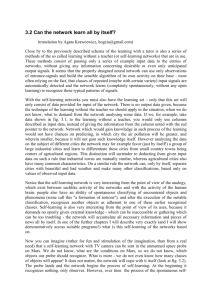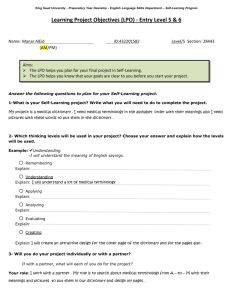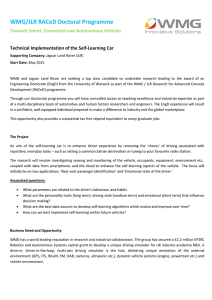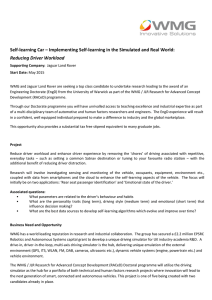A Study of Raising Self-learning Ability by Network in
advertisement
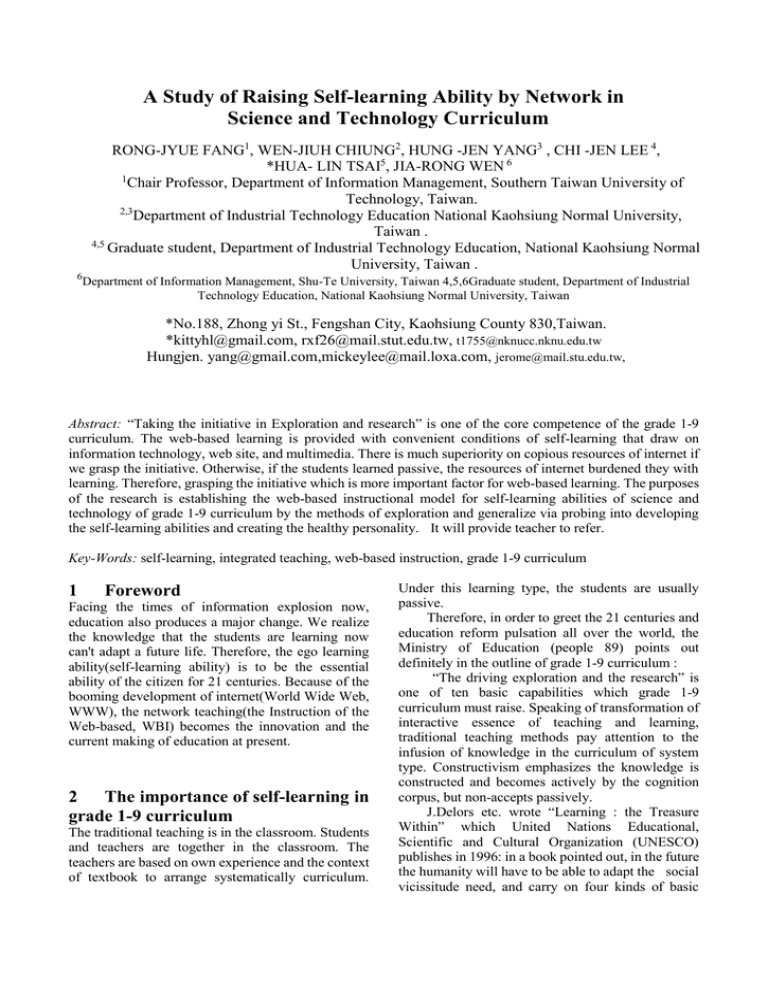
A Study of Raising Self-learning Ability by Network in Science and Technology Curriculum RONG-JYUE FANG1, WEN-JIUH CHIUNG2, HUNG -JEN YANG3 , CHI -JEN LEE 4, *HUA- LIN TSAI5, JIA-RONG WEN 6 1 Chair Professor, Department of Information Management, Southern Taiwan University of Technology, Taiwan. 2,3 Department of Industrial Technology Education National Kaohsiung Normal University, Taiwan . 4,5 Graduate student, Department of Industrial Technology Education, National Kaohsiung Normal University, Taiwan . 6 Department of Information Management, Shu-Te University, Taiwan 4,5,6Graduate student, Department of Industrial Technology Education, National Kaohsiung Normal University, Taiwan *No.188, Zhong yi St., Fengshan City, Kaohsiung County 830,Taiwan. *kittyhl@gmail.com, rxf26@mail.stut.edu.tw, t1755@nknucc.nknu.edu.tw Hungjen. yang@gmail.com,mickeylee@mail.loxa.com, jerome@mail.stu.edu.tw, Abstract: “Taking the initiative in Exploration and research” is one of the core competence of the grade 1-9 curriculum. The web-based learning is provided with convenient conditions of self-learning that draw on information technology, web site, and multimedia. There is much superiority on copious resources of internet if we grasp the initiative. Otherwise, if the students learned passive, the resources of internet burdened they with learning. Therefore, grasping the initiative which is more important factor for web-based learning. The purposes of the research is establishing the web-based instructional model for self-learning abilities of science and technology of grade 1-9 curriculum by the methods of exploration and generalize via probing into developing the self-learning abilities and creating the healthy personality. It will provide teacher to refer. Key-Words: self-learning, integrated teaching, web-based instruction, grade 1-9 curriculum 1 Foreword Facing the times of information explosion now, education also produces a major change. We realize the knowledge that the students are learning now can't adapt a future life. Therefore, the ego learning ability(self-learning ability) is to be the essential ability of the citizen for 21 centuries. Because of the booming development of internet(World Wide Web, WWW), the network teaching(the Instruction of the Web-based, WBI) becomes the innovation and the current making of education at present. 2 The importance of self-learning in grade 1-9 curriculum The traditional teaching is in the classroom. Students and teachers are together in the classroom. The teachers are based on own experience and the context of textbook to arrange systematically curriculum. Under this learning type, the students are usually passive. Therefore, in order to greet the 21 centuries and education reform pulsation all over the world, the Ministry of Education (people 89) points out definitely in the outline of grade 1-9 curriculum : “The driving exploration and the research” is one of ten basic capabilities which grade 1-9 curriculum must raise. Speaking of transformation of interactive essence of teaching and learning, traditional teaching methods pay attention to the infusion of knowledge in the curriculum of system type. Constructivism emphasizes the knowledge is constructed and becomes actively by the cognition corpus, but non-accepts passively. J.Delors etc. wrote “Learning : the Treasure Within” which United Nations Educational, Scientific and Cultural Organization (UNESCO) publishes in 1996: in a book pointed out, in the future the humanity will have to be able to adapt the social vicissitude need, and carry on four kinds of basic learnings [1]: learning to know、learning to do、learning to live together and learning to be. [2,3] Xu pearl (people 90) once indicated that, time explodes which in the information, the new knowledge every seven years doubles, studing the knowledge from the school, falling behind three to five years. The new information inflates fast, and forces the people to have by the quicker speed renewal knowledge and the technology, thus causing the motion of people do not to be separated from the reality. Driving exploration and research: stimulating curiosity and observation, initiatively exploring and finding the problem, positively utilizing the studied knowledge in life. 2.1 Strengthen the consciousness of students' self-learning The consciousness of self-learning means that students fully know they themselves are the master of learning. Strengthening the consciousness of students' self-learning is to make students carry on the process of independent study and independent activity under the teacher guidance. According to the philosophy epistemology, practice, value and the related theories of pedagogy and psychology, the consciousness of students’ initiative study mainly expresses independent independency, self-conscious activity and creative expansibility. The independent independencies mainly means that the main body exercises and control the consciousness and ability of one’s own right. It is the premise and the foundation which the human initiative studies. It concentrates to express ego consciousness, like self-confidence, self-respect, self-consciousness, independent, as well as self-encouragement, self-regulation and self-appraisal ability and so on. The self-conscious activity can be the most basic characteristic of consciousness of initiative study. It mainly means that a person positively self-consciously knows and acts, and actively adaptes and remakes objective world with an attitude of choice and participation. To students, this activity expresses not only in learning activities, but also in the individual life and social activities. The creative expansibility is one kind of transcendence to reality, and the highest manifestation of consciousness development which students initiatively study. 2.2 Develop the ability which students initiatively study 2.2.1 Development and enhancement of self-educated ability Having strong self-educated consciousness, students can plan a self-educated project, choose self-educated material and control a good self-educated method. If students have a good self-educated habit, they can have an ability of preview and review actively. The scope of preview and review doesn't limit at text knowledge (including students study by themselves in the classroom)(classmates of condition can gain more related knowledge from on-line.) 2.2.2 Development and the enhancement of work practice ability Having work operation consciousness, students are requested to be able to work, work hard and be good at work. Having an initial ability of science experiment, an ability of dealing with daily business and the spirit of daring exploration, students must dare to strive for " The first person eating crab", then having the motive of fulfillment. 2.2.3 Development and enhancement of observation ability In learning, students have to be good at observation (for example, observe a reaction of experiment), which needs to be careful, from various angles, and noticing the phenomenon other people have never observed. 2.2.4 Development and enhancement of emergency ability Possessing emergency consciousness, students control common emergency knowledge. Emergency ability should integrate into each kind of ability. (like science subject : students has done one type of question, and they must be able to understand the resemble questions by analogy. 2.2.5 Development and enhancement of thinking ability Develop the ability of students who apply analogy, induction, summarization, inference, deduction etc. to analyse problem and solve problem. A. Thinking ability run through the process of self-learning (for example, in the reading process, students think to the related context from multiple angle, then they can find problem variously, and enabling the surface of self-learning to be broader and deeper. B. Practice is not blind, but is with a clear goal, in the time of ponder or after thinking. Therefore, thinking ability run through practice. C. Observation also run through thinking (for example, when you once observed the phenomenon that other persons did not observe, you had to ponder “why” and try to discover reasons). That is how the innovation comes. 2.2.6 Development and enhancement of choice judgment ability Have the choice judgment consciousness. Now entering a newt information time, the junior high school students face “the information flow” which comes from various places. The context of information and its miscellaneous things benefit to the junior high school students, but also harm them. Students should study the choice judgment to enhance own immunity, absorb its essence and give up its dross. 2.3 Model the integrated main personality for students 2.3.1 Train students for a good learning motive Learning motive is one kind of inner dynamics which impels students to carry on study directly. It displays many learning forms, like intention, desire or interest and so on. 2.3.2 Stir up students higher interest in the learning The study interest is to express vigour satisfaction under the process of overcoming difficulties with each concrete stage of controlling knowledge and completing actual mission 2.3.3 Train students for the emotion of initiatively study Students are trained for classic moralities, including regular learning attitude, stronger sense of honor and obligation. Students are induced to pursue the beautiful psychological trend and to engender the beautiful psychological feeling. 2.3.4 Train students for the will of initiatively study The will is the psychology which decides to reach a certain purpose, expressing by the language and the behavior. Training students for the will of initiatively study makes students keep a good and stable mood condition with firm learning perseverance, better mood stability, attention stability and stronger anti-setback ability in the study process. 3 The foundation of theory of self-learning ability In the conventional teaching, students learn by teachers, using blackboard and teaching media assistance. Teachers are the dominator in entire teaching process, but education emphasizes that students are the main body, which students are the center. In the conventional teaching, we could not see students’ activity which is given, but students are placed in a passive position. 3.1The information processing theory of cognitive learning and learning Cognitive learning to conditioning learning emphasizes that the way of more complicated mankind learning can not explaine by simple stimulation and response joint. Approximately, it inquires into two subjects, “how can the human know” and “the human how to obtain knowledge”[4]. Lately cognition psychology scholars specially emphasize that the individual main body and curiosity[5]. The scholars with the sociality and the human nature to external message stimulation will actively and progressively analyze and reorganize when they are learning, and not rely on the pure stimulation and response jointing. Zhang, Chun-Xing (people 79) synthesized various opinions, thought that: The cognitive process includes the complex processes, like feeling, consciousness, attention, image, memory, ponder, inference, judgment, language utilization, mental development as well as the adaptation environment, solving the problem and so on. …The information processing theory emphasized how the individual utilizes the equipment in its physiology to “process” the related “the news” in the environment, then giving play to the function of adaptation after obtaining knowledge. The information processing theory mainly is to analyze the operation of the mankind innate cognitive organization and cognitive process. This theory mostly is on the basis of viewpoint of Atkinson and Shiffrin[9], and then moderately developing to form itself[10]. Now discuss the information processing which proposed (see Figure 1) [4,5]. He thought that the process operations of individual study, memory and recollection etc. are affected by “expect” and “the control execution” . Basing on the operation difference of “expect” and “the control execution”, the study result also Execute control difference[11]. expectation long-term remember feeling recorder a short-term remember acceptor environment executive 境 reaction form has Fig 1 The information processing model [4,5] The relation between the information processing theory and the study are narrated as follows: 3.1.1 The high level cognitive process exists in the study process The majority cognitive scholars thought that all cognitive activities for people are restrained a high level cognitive process, calling meta-cognition[11]. The domestic scholars translated it into “the cognitive cognition”[12], referring to each all sorts of coordination activities for the individual to achieve the study needs. In other words, i.e. consciousness and control for individual to own cognitive process. [13] Discussing students study with the cognitive viewpoint pointed out that common learning process usually involves two kinds of high level cognitive processes, the first kind is in various activities of the plan, the arrangement, the coordination, direction and supervision. For example, plan and predict the information suffered, guess and guard of learning process. The second kind is to understand the teaching material and the study strategy for the individual. For example, whether students have already understood what they study or not. Whether the process and the step have already completed and so on. 3.1.2 The learner acts the initiative positive construction role in the entire study process In view of the information processing pattern, the learners actively receive the message from the external environment in learning process, and also do not make mechanical response to the external stimulation. Pointed out from many researches, in entire learning process, if the learners can play initiative, positive construction role, they can compare with effective attribute message, choice message, annotation message, organization message, then be able to select the different strategies to produce the appropriate response. 3.1.3 The importance of the prior knowledge The knowledge is formed by accumulating a long period of time. This characteristic of knowledge has been accepted generally by the populace. Based on this, the understanding and absorbability of the new knowledge have the close relationship with the knowledge which has already known. Generative learning model by explains the importance of this relation [14,15] : the prior knowledge affects not only the degree of understand the new learning material, but also the interest and choices to external information. If the prior knowledge is an incorrect thought, this thought will not easily change after studying, even causing the barrier in the study when misunderstands the teaching material content. 3.1.4 The study is the concept change The former knowledge plays the important role in the process of learning new knowledge. In the process of new learning, the learners utilize the old knowledge which was stored in the memory system, understanding the new knowledge and assimilating to the original construction, or giving up original construction to comply with the new structure. Then the learners will attribute and organize the knowledge to obtain the change in the study. Based on this, schema theory were produced in the late 1970[16] . So-called “schema” (plural number schem-ata) refers to the organized abstract concept construction. It usually uses to represent some facts, the concept, the principle or the operational behavior. The relation between each other constitutes an organized network structure. This network structure may be the horizontal tandem type, also may be the vertical tandem type. 3.2 The meaning of self-learning ability The definition and connotation of self-learning ability show, as follows : 3.2.1 The definition of self-learning ability Self-learning ability in past research still did not aim at this noun to make an accurate definition. In the related realm of self-directed learning, the scholars on the self-guidance learning ability aspect make clear definition, as follows: Guglielmino pointed out in his doctoral dissertation published [3] : The self-guidance study means that individual can initiate the study by oneself, independent and continuous carry on the self-training ability, has the intense study desire and the confidence, apply basic study skill, arrange the suitable study step, and develop complete study plan using the free time. It is clear about self-guidance learning ability that is the ability with drawing up the plan and evaluating study result. 3.2.2 The connotation of self-learning ability The support systems include the education unit providing the study information, the publishing house, the bookman, the computer information network system and so on. In addition, from utilizing this two factor to further investigation, it involves to the question that the learners in the study process whether has “ability” and “the opportunity” to utilize this two essential factor or not. This ability and the opportunity can affect the self-guidance study effect. Next, because self-guidance study refers to an ability which is one kind of study results, cultivation of self-guidance learning ability has possibility and the value. 4 Discussion in Network teaching strategy The network teaching is a teaching plan which makes use of the characteristic and the resources of the World Wide Web, and based on the hypermedia, creating the significant learning environment with a support and the promotion study[4,5]. Simultaneously, [8] also aims at the characteristic of the network learning environment to propose his view, after like: (1) Interaction : In the network, students can be interactive with other participants, teachers and on-line resource. (2) Emergence of multimedia : Curriculum in the network can conform many learner's study styles by multimedia (e.g.: the writing, the design, the movie, the animation and so on). (3) Open system : Comparing with more sealed learning system(as:CD-Title, book), the learners can arbitrarily go to the website which they want by the hyperlink. (4) on-line inquiry : students can make use of research engine to search network resource which related with the curriculum, and uses the writing and the title which appears many times in the curriculum as the index then making the further inquiry again. (5) Independence of equipment, distance and time : students can get on the web site for learning from any location, any time and any computer. (6) Global searching : users can search worldwide information on-line in any location through network tools, and react with experts anywhere. (7) Electronic publication : network offers convenient ways for students and teachers to upload their works onto the net, so people all over the world can access. (8) On-line resource : numerous information are offered by the network, and can renew at any time. This special characteristic help teachers be able to obtain the latest resources to apply in the teaching. (9) Dispersiveness : In the network multimedia resources disperse each place server in the world, therefore each person can become the provider of the resources. (10) Trans-Culture interaction : The network-based teaching provides an environment that supplies the learners and the teachers to interact with people around the (11) expert resource : Due to the characteristic which the network surmounts the national boundary, the network-based teaching can make use of expert's instruction from each place, and will help to student's study. (12) learners’ control : The network has provided flexbible and the opening learning environment, and learners can participate discussion initiatively, or only glance over. Therefore, students in the network-based teaching can own the control right with the content, the time and the feedback choice, and have the independent right in the study. (13) convenience : Students can register, do assignment, research and even communicate with teachers directly by the network. Teachers also can take advantage of this to renew the content of curriculum. These all may carry on with the immediate or the non-immediate form. proposed the characteristic of network study [14], after like: (1) The network has provided the fast and the economical search way, and may supply on-line search for the characters as well as various type-like material. (2).The network has the fast renewal characteristic, and makes the content of network which compares with other media be richer and novel. (3). The network may share individual work with other people around the world. (4).The characteristic of the hyperlink provides fexible and massive study resources, causing students' study no longer to limit in the fixed place and the content. Because the network study had these characteristics, the network teaching was prosperous day after day, and the development of teaching method was also vigorous in recent years. [16]Ttidied up the teaching strategy which often used in the network teaching, as table 1 show: Chart1 network teaching strategy [1] Dissemination Teaching Purpose IimplementTeaching Activity Model Information 1. issue curriculum news Dissemination : 2. organize, reorganize network resources and interlink make use of 3. provide digit information hyperlink and 4. the form of give lessons is similar to curriculum conventional teachingmodel information in homepage to disseminate information assist student 1. provide guidance , lead to discussion , suggest related resources 2. It is through E-mail, listsev, Web conference and MUD(Multi user Dialogue) environment to provide assistance. student’s 1. provide an environment which can communication support stusents toask questions, clarity direction, raise suggestion or related resources, and go on cooperate project 2. take E-mail, listsev, Web conference and MUD(Multi user Dialogue) as tools interact with 1. invite outside experts to participate outside in Web conference 2.homepage interlink outside resources 3. provide to interlink MUD environment 4. participate in other network social groups outside experts 1. outside experts are aimed at the provide guidance of some special learning guidance activities 2. take E-mail, listsev, Web conference and MUD(Multi user Dialogue) as tools announce 1. aim at a special subject to reach the content purpose of assimilating, interacting and reforming information by creation, organization and reorganization 2. practicable activity, like issue homepage, article or comment imitate 1. by MUD environment, it is based on a role play centre subject to create a learning activity which has many roles and situation. behaviour 1. scope includes from sample network imitation behavior to curriculum related sample 2. provide guidance to help students interact in fictitious environment 3. issue discussion, do assignment, implement project sample in WWW Facilitation Inside collaboration interaction, the game, the simulation and the inquisition study. First, teachers understand students’ prior knowledge and guide students' exploration skill. Second, after the network operation demonstration, teachers instruct the students according to prior knowledge to make the probe-like presentation practice, letting students feel the achievement of presentation. Third, to initiate students’ motive of voluntary exploration study, teachers can make use of teaching strategies, such as the explaination, the demonstration, the community interaction, the game, the simulation and the inquisition study and so on, to practice. Then teachers guide students to transform and to be skilled the study, initiating students to spontaneously utilize skills, like the exploration, the simulation, the interaction and so on. In this circulation, teachers operate repeatedly to achieve the goal of the stimulation motive. Finally, by producing development, teachers interact with exterior cooperation again to strengthen students’ self-confidence to achieve deepened the study interest. (detailed as shown in Figure 2). Understand students’ prior outside collaboration ─interact with outside knowledge Outside collaboration guide exploration skill 促進(facilitation)─協助學生 Network operation demonstration Explore to product development practice Apprentice Ship Initiate students self- exploration, discover learning motive Generative Development Inside collaboration ─student’s communication Guide students to transform and skill Initiate students to spontaneously Role Play use the skills, like exploration, simulation, interaction and discovery. Model Produce development ─ announcement by the process of selfexploration Fig. 2 The network teaching model of raising self-learning ability in science and technology curriculum 5 The Network Teaching Model of Raising Self-learning Ability in Science and Technology Curriculum Kemp(1988) pointed out that the suitable teaching strategies for the technical education have the explanation, the demonstration, the community 6 Conclusion Learning is a very pretty thing. By the learning, we renew to create ego. By the learning, we can do the thing that we had never done, and renew to know this world and the relation between us and it, developing the ability of creating the future. 「learning」is like「flowing water」 whose life and growth in nature, pouring into the organization whose ability will unceasingly transform to respond to the trend of the time which changes fast. After experiencing the research by oneself, each student will possess own knowledge, and study the completely responsible study manner in the process of research, then experiencing the self-realization, constructing the self-confidence, initiating the self-learning motive and desire, and achieving lifelong self-learning idea. References [1]Banna, Brenda & Milheim, W.J.(1997). Existing Web-based Instruction Course and Their Design. In Badurl H. Khan(eds.). Web-based instruction. NJ: Englewood Cliffs. [2]Flavell, J. H. (1979). Metacognition and cognition monitoring: A new area of cognitive developmental inquiry. American Psycologist ,34 ,906-911. [3]Gagne, R. M. (1985). The condition of learning (4th ed.). New York: Holt Rinehart & Winston. [4]Gagne, R. M., & Medsker, K. L. (1996). The conditions of learning: Training applications. Forth Worth, TX: Harcourt Brace College. [5]Guglirlmino, L. M.(1977). Development of the self-directed learning readness scale. Unpublished Doctoral Dissertation. University of Georiga. Dissertation Abstracts International, 38, 6467A. [6]Hackbarth, Steve.(1997). Integrating Web-based Learning Activities into School Curriculum. Education Technology, May-June, 59-67. [7]Kemp, W. H. (1988). Introduction to instructional strategies. In W.H. Kemp, & A., E. Schwaller. (Eds.), Instructional strategies for technology education, (p16-34), 37th Yearbook of the Council on Technology Teacher Education. Mission Hills, CA: Glencoe Publishing Company. [8]Khan, B. D.(1997). What is Web-Based Instruction? Australian Catholic University, retrieved October 17, 2002, form the World Wide Web: http://www.acu.edu.au/fed/nsw/information/courses/e dst504/modules/topic_1/topic_1.html Kratz, Russel J. (1980). Implications of self-directed learning for functionally illiterate adults. (Report No. CE023988) Vancouver, BC, Canada: Adult Education Research Conference. (Eric Document Reproduction Service No. ED185247) [9] R. J. Fang, H. J. Yang, C. C. Lin, H. H. Yang, and J. C. Yu, "A Comparison of Applying the Theory of Reasoned Action and the Theory of Planned Behavior on Predicting On-line KT Intention," WSEAS Transactions on Mathematics, vol. 6, pp. pp.432-438, 2007. [10] R. J. Fang, H. J. Yang, H. L. Tsai, C. J. Lee, and C. C. Lin, "Global d-Learning through Internet for grades 1-9 Students- Aviation Technology Education," WSEAS Transactions on Advances in Engineering Education, vol. 4, pp. pp.17-25, 2007. [11] R. J. Fang, H. J. Yang, H. L. Tsai, C. J. Lee, and T. S. Tsai, "An International Culture Online Exchange Model of K-12 Students," WSEAS Transactions on Mathematics, vol. 6, pp. pp.426-431., 2007. [12] H. H. Yang and H. J. Yang, "University Students' Friendship Discrepancy and Time Spent on the Internet," WSEAS Transactions on Mathematics, vol. 6, pp. pp.191-194, 2007. [13] H. H. Yang, J. C. Yu, and H. J. Yang, "A Study of Statistical Software Acceptance Based upon TRA Model," WSEAS Transactions on Advances in Engineering Education, vol. 4, pp. pp.83-90, 2007. [14] H. H. Yang, J. C. Yu, H. J. Yang, and Y. M. Chu, "A Traffic Model of Online Surveying Based upon National Teachers' Investigation," WSEAS [15]Mc Keachie, W. J.(1976). Psychology in America's bicentenneal year. American Psychologist, 31, 819-833. [16]O' Brien M. (1997). Profit From Experience: The Individual's role in the learning organization, New York: American Monagement Association, Unpublished.

